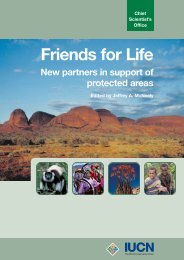Dolphins, Whales and Porpoises: 2002-2010 Conservation - IUCN
Dolphins, Whales and Porpoises: 2002-2010 Conservation - IUCN
Dolphins, Whales and Porpoises: 2002-2010 Conservation - IUCN
You also want an ePaper? Increase the reach of your titles
YUMPU automatically turns print PDFs into web optimized ePapers that Google loves.
population. Therefore, no exceptions should be allowed<br />
to the national law that prohibits dolphin<br />
captures (IWC 2001a).<br />
� Because of concern about the habitat degradation <strong>and</strong><br />
physical displacement of dolphins <strong>and</strong> their prey<br />
caused by large coal-carrying ships, alternative means<br />
of coal transport, such as smaller, less destructive<br />
barges, should be employed.<br />
Irrawaddy dolphins in Malampaya<br />
Sound, Philippines<br />
History: A geographically isolated population of Irrawaddy<br />
dolphins was recently discovered at the head of Malampaya<br />
Sound, Palawan, Philippines (Dolar et al. <strong>2002</strong>). Linetransect<br />
surveys conducted in 2001, as part of the WWF-<br />
Philippines Malampaya Sound Ecological Studies Project,<br />
estimated that the total population consists of 77 individuals<br />
(CV 27.4%) confined to a 133km 2 area in the inner sound<br />
(Smith, unpublished data). Between February <strong>and</strong> August<br />
2001, researchers from the same project confirmed that two<br />
dolphins were accidentally killed in bottom-set nylon gillnets<br />
used to catch crabs (called matang quatro nets locally).<br />
They also received reports from local fishermen that as<br />
many as three additional dolphins were killed in these nets<br />
during the same period. These findings strongly suggest that<br />
the Irrawaddy dolphin population in Malampaya Sound is in<br />
immediate danger of extinction due to low numbers, limited<br />
range, <strong>and</strong> high mortality. This is the only known population<br />
of the species in the Philippines, <strong>and</strong> the nearest area where<br />
another population of this coastal <strong>and</strong> riverine species is<br />
known to occur is in northern Borneo, some 550km to the<br />
south.<br />
Fishermen in Malampaya Sound are generally poor, <strong>and</strong><br />
the crab fishery provides substantial employment <strong>and</strong> income<br />
in an economically depressed region. This fishery<br />
requires little monetary investment <strong>and</strong> is therefore an attractive<br />
local employment option. It would be inadvisable to<br />
prohibit this fishing technique without providing alternatives<br />
that ensure an equal or greater income to the fishermen.<br />
<strong>Conservation</strong> recommendations: Immediate action is<br />
needed to prevent the extirpation of Irrawaddy dolphins<br />
from Malampaya Sound. The CSG therefore recommends<br />
that dolphin mortality in the crab fishery be eliminated or at<br />
least drastically reduced. Similar to the situation of the<br />
vaquita, this will require action on the socio-economic front<br />
as well as assistance from cetacean <strong>and</strong> fishery scientists.<br />
The CSG therefore strongly urges that socio-economic<br />
alternatives be developed to help promote the conservation<br />
goal of reducing entanglement in matang quatro gillnets. In<br />
addition, we emphasize the need for long-term monitoring<br />
of dolphin abundance <strong>and</strong> mortality in Malampaya Sound<br />
(IWC 2001a).<br />
89<br />
Short-beaked common dolphins in the<br />
Mediterranean Sea<br />
History: Historical literature, photographic documentation,<br />
<strong>and</strong> osteological collections indicate that the short-beaked<br />
common dolphin was once abundant in much of the<br />
Mediterranean Sea (Figure 37). However, the species has<br />
experienced a dramatic decline in numbers during the last<br />
few decades, <strong>and</strong> has almost completely disappeared from<br />
large portions of its former range, particularly in the central<br />
Mediterranean Sea (UNEP/<strong>IUCN</strong> 1994; Forcada <strong>and</strong><br />
Hammond 1998). There is no overall abundance estimate<br />
for short-beaked common dolphins in the Mediterranean<br />
Sea. Line-transect surveys in 1991 <strong>and</strong> 1992 in the western<br />
basin found them to be abundant only in the Alboran Sea<br />
between southern Spain <strong>and</strong> Morocco (approx. 15,000 individuals<br />
in the south-western stratum)(Forcada 1995), while<br />
sighting frequencies in other western Mediterranean areas<br />
were very low (Forcada 1995; Forcada <strong>and</strong> Hammond<br />
1998). Genetic studies indicate significant divergence between<br />
Mediterranean <strong>and</strong> Atlantic populations; genetic exchange<br />
seems to be limited to the Alboran Sea, possibly due<br />
to local oceanographic features (Natoli in press). There is<br />
also no evidence of significant movement through the narrow<br />
Dardanelles Strait between the Aegean <strong>and</strong> Marmara<br />
Seas. Despite growing interest in cetacean conservation, <strong>and</strong><br />
the recent implementation of regional treaties <strong>and</strong> agreements<br />
(i.e., the Barcelona Convention Protocol on Specially<br />
Figure 37. Short-beaked common dolphins, mother <strong>and</strong><br />
calf, in the eastern Ionian Sea. The marked decline in<br />
abundance of common dolphins in the Mediterranean Sea<br />
is a conservation challenge. Immediate measures are<br />
needed to allow the species to recover, yet the causes of<br />
its decline in this region are not well understood.<br />
Photo: Tethys Research Institute/Elena Politi.






